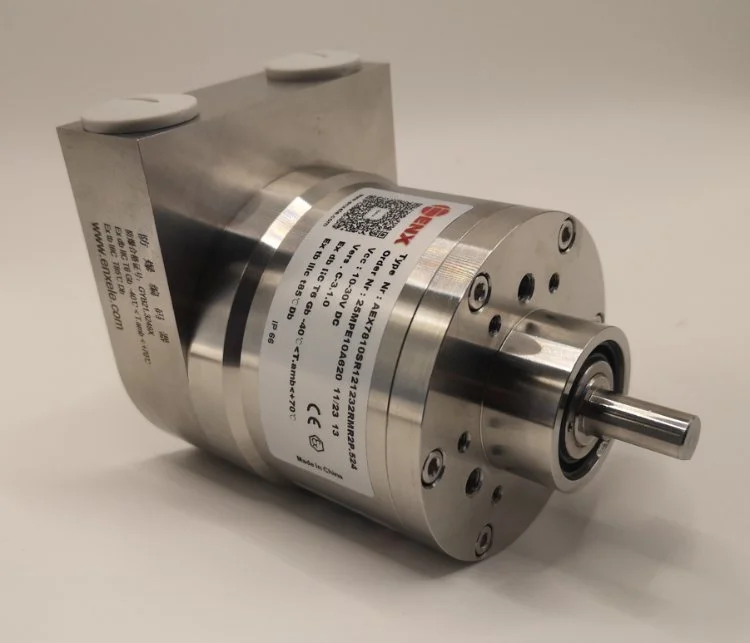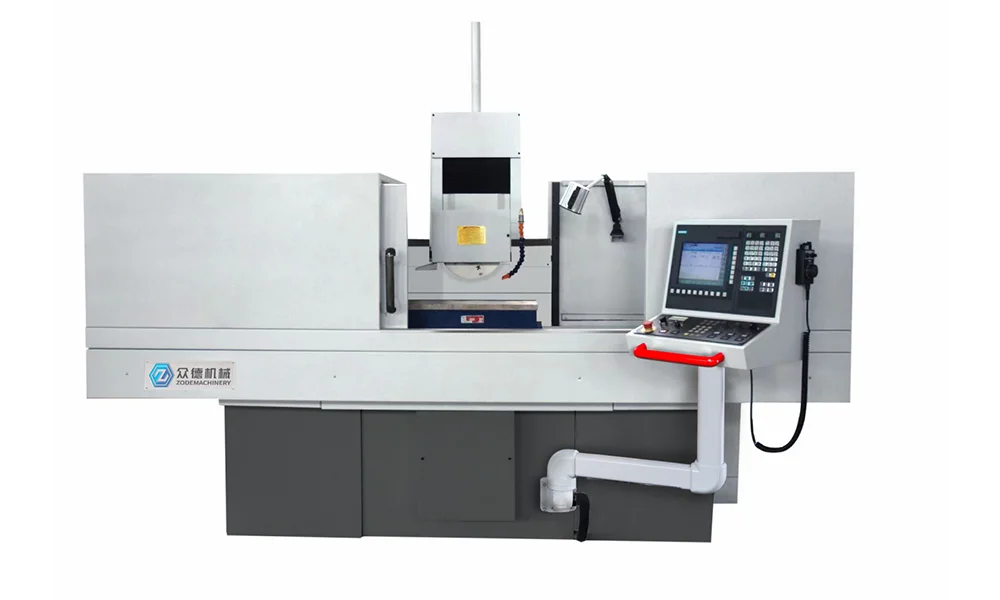Industrial Applications of Absolute Rotary Explosion-Proof Encoder
In industries where safety, precision, and reliability intersect, the need for advanced position feedback devices becomes non-negotiable. As a high precision industrial encoder manufacturer, ENX Enxiao will share the industrial applications of absolute rotary explosion-proof encoder for sale.
Understanding Absolute Rotary Explosion-Proof Encoder
Before delving into industrial use cases, it's important to briefly clarify what an absolute rotary explosion-proof encoder is. This type of encoder provides a unique digital code for each shaft position, ensuring that the position data is never lost—even after power cycles or system resets. What sets the explosion-proof variant apart is its certification for use in potentially explosive atmospheres, such as those laden with flammable gases, vapors, or dust. These encoders are typically designed to comply with standards such as ATEX (EU), IECEx, and UL/CSA (North America).
Explosion-proof encoders feature rugged enclosures, often made from stainless steel or anodized aluminum, with specialized seals and flame paths to prevent the ignition of surrounding hazardous materials.
Absolute Rotary Explosion-Proof Encoder Applications
1. Oil and Gas Industry
Use Case: Drill Rig Positioning and Valve Control
The oil and gas sector is perhaps the most prominent user of explosion-proof sensors. Onshore and offshore drilling platforms feature volatile atmospheres due to the presence of hydrocarbons. In such environments, absolute rotary explosion-proof encoders are utilized to monitor:
Top drive and draw works positioning for accurate drill string control.
Rotary table angles, ensuring real-time feedback during directional drilling.
Valve actuators on Christmas trees and wellheads, ensuring precise control of flow systems.
These encoders help maintain operational safety and data continuity, even in the event of blackouts or sudden shutdowns. Their resistance to mechanical shock, vibration, and corrosive elements makes them indispensable.
2. Chemical Processing Plants
Use Case: Reactor Agitator Monitoring and Conveyor Alignment
Chemical manufacturing facilities involve reactions with volatile gases, solvents, and fine particulates. In such ATEX-zoned areas, maintaining precise angular feedback from motorized equipment is critical. Explosion-proof encoders are widely installed in:
Agitator systems in chemical reactors for monitoring rotational speed and shaft position.
Pneumatic and electric actuator systems for valve and damper control.
Material handling systems, such as bucket elevators and screw conveyors.
By using absolute encoders, facilities prevent position ambiguity after power failures, ensuring process continuity and avoiding the risks of unintentional misalignment or overflow.
3. Mining and Tunneling Equipment
Use Case: Conveyor Systems and Drilling Machines
The mining industry involves inherently hazardous atmospheres rich in combustible dust (e.g., coal dust), often classified under Zone 21 or 22 (dust) in ATEX directives. In this context, absolute rotary explosion-proof encoders play a crucial role in:
Monitoring rotary motion on underground conveyors to manage load distribution and avoid system jamming.
Position feedback in tunnel boring machines (TBMs) and mobile mining units to ensure correct bore path control.
Hoist systems used for transporting personnel or ore, where accurate encoder feedback ensures safety and prevents over-travel.
These encoders not only ensure safety compliance but also contribute to the optimization of complex logistics and heavy machinery coordination underground.

4. Pharmaceutical Manufacturing
Use Case: Cleanroom Robotics and Precision Dosing
Though often considered less hazardous than chemical plants, pharmaceutical facilities can involve flammable solvents and powders, particularly in tablet coating or sterile compounding areas. Explosion-proof absolute encoders are used in:
Automated robotic arms for sterile filling and packaging processes where precision is paramount.
Rotary index tables used in tablet presses and encapsulation machines.
Automated guided vehicles (AGVs) operating in hazardous material storage zones.
In these applications, the encoder' s explosion-proof design ensures compliance with safety regulations, while its absolute positioning supports high precision in dosage control and traceability.
5. Food and Beverage Processing
Use Case: Rotational Feedback in Spray Drying and Mixing Systems
Surprisingly, some food processing environments—especially those involving spray drying, grain storage, or sugar refinement—can develop explosive dust clouds. In such Zone 22 environments, explosion-proof encoders are used for:
Monitoring rotational speed in mixers and blenders to ensure batch consistency.
Controlling rotary valves and screw feeders to manage flow rates of flour, sugar, and starch.
Tracking position in high-speed packaging and labeling machines.
Encoders help maintain strict hygienic and operational standards, integrating well with CIP/SIP (Clean-In-Place/Sterilize-In-Place) protocols thanks to their sealed and corrosion-resistant housing.
6. Renewable Energy and Hydrogen Production
Use Case: Electrolyzer Valve Actuation and Biogas Plant Automation
With the expansion of the hydrogen economy and green energy facilities, new areas requiring explosion-proof instrumentation are emerging. Hydrogen is highly flammable and requires stringent monitoring:
Electrolyzer systems use explosion-proof encoders to regulate rotary valves that control gas flow and cooling systems.
Biogas reactors and fermenters often involve combustible methane and benefit from precise agitator position control.
Wind and solar hybrid systems in remote hazardous zones use encoders to track yaw and pitch in wind turbines and heliostats.
These encoders enable fault-tolerant feedback critical to the efficiency and safety of renewable energy operations.
7. Aerospace and Defense Fuel Systems
Use Case: Fuel Pump and Tank Monitoring
Fuel handling and storage in aerospace maintenance facilities involves significant explosion hazards. Encoders in these environments must withstand not only explosive atmospheres but also:
Extreme temperatures
Mechanical vibration
EMI/RFI (Electromagnetic/Radio-Frequency Interference)
Explosion-proof encoders are installed in fuel pump monitoring systems, rotary actuators for nozzle positioning, and refueling arm articulation. Absolute positioning ensures that systems can be immediately restored to a known state after power loss—vital in mission-critical operations.
8. Marine and Shipbuilding Applications
Use Case: Propulsion System Feedback in Tankers and LNG Vessels
Marine vessels such as oil tankers, LNG carriers, and chemical cargo ships pose similar explosion risks to land-based petrochemical facilities. Explosion-proof encoders are used for:
Position feedback in variable pitch propellers (VPP)
Rudder angle monitoring
Valve actuation for ballast and fuel systems
Given the presence of saltwater and constant vibration, these encoders must meet IP68+ ingress protection standards and be constructed from marine-grade materials.
9. Automation and Robotics in Hazardous Areas
Use Case: Ex-Rated Collaborative Robots (Cobot) Feedback Systems
Emerging technologies are enabling the use of explosion-proof robotic systems in hazardous zones, such as Ex-rated cobots for inspection and maintenance. Encoders are vital for joint articulation tracking and path control. They enable:
Safe movement in volatile environments
Consistent operation during shutdown/restart cycles
Compliance with safety redundancy protocols (e.g., SIL2/SIL3)
These advanced applications require encoders with integrated communication protocols such as PROFINET, EtherCAT, or CANopen, often embedded with safety layers like Functional Safety over EtherCAT (FSoE).
Conclusion
Absolute rotary explosion-proof encoders serve as the backbone for precision motion control in hazardous environments across multiple industrial sectors. From drilling rigs to cleanrooms, and from mining shafts to robotic arms, these rugged and intelligent devices ensure operational continuity, safety compliance, and system reliability. Their versatility, combined with their capacity to deliver unambiguous position data even during power failures, makes them a critical component in the future of industrial automation.
As industries continue to embrace digital transformation in increasingly complex environments, the role of explosion-proof absolute encoders will only grow. They represent the synergy of mechanical resilience, electrical sophistication, and compliance-driven engineering, enabling smart control in the most demanding and dangerous workplaces.
www.enxsensors.com
ENX Enxiao

Average Rating